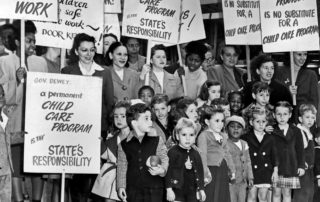Economic Security, Mobility and Equity (ESME)
Whether paid or unpaid, women’s work is crucial for their families’ economic security and well-being. Greater gender equality in paid and unpaid work will reduce poverty and improve economic growth and prosperity; persistent inequity in employment and family work is costing all of us. Women are held back by the undervaluation of historically female work, workplaces designed as if workers had no family responsibilities, and a broken-down work-family infrastructure.
IWPR’s ESME program highlights the extent of pay inequalities, and the role played by stark occupational segregation in perpetuating unequal pay. We conduct research and analysis on women’s labor force participation and employment trends; workforce development, non-traditional employment, and apprenticeships; the impact of sex discrimination and harassment on women’s career advancement and mobility; the gender pay gap and pay inequity across race and ethnicity; work-family policies and employer practices; the and the impact of automation and technological advances on women workers.
We work with policymakers, employers, advocates, and practitioners to identify promising practices and policy solutions.
Women and the COVID-19 Pandemic: Five Charts and a Table Tracking the 2020 “She-Cession” by Race and Gender
The COVID-19 pandemic has been devastating for the U.S. economy, and women, particularly women of color, have been hit especially hard. 2020 ended with women’s numbers of jobs on payroll being still much further below their February levels than men’s.
Building a Better Future for Women in New Orleans Post COVID-19: Opportunities for Women in Skilled Trade and Technical Jobs
Women in New Orleans are particularly severely affected by COVID-19 related job losses because they are more likely than men to work in leisure and hospitality and tourism. Women are much less likely than men to work in construction, manufacturing, transportation, and Port-related jobs,
Women’s Share of Unemployment Insurance Claimants varies Strongly Across States
In 42 of 50 states and DC, women were the majority of unemployment insurance claimants. A third of all unemployed women, and four in ten Latinas, have been out of work for more than 26 weeks. The receipt of unemployment benefits, including those provided under the CARES Act, substantially reduces but do not eliminate the odds of hunger or foreclosure threats for women and their families.
Build(ing) the Future: Bold Policies for a Gender-Equitable Recovery
This report, Build(ing) the Future: Bold Policies for a Gender-Equitable Recovery, provides a framework for shared prosperity and equitable economic recovery. It examines the impact of the economic crisis and recession on working women, their families, and communities.
Despite Modest Employment Gains, Women Still 5.5 Million Jobs Below Pre-Pandemic Level
New October jobs data show women gained 280,000 (43.9 percent) of 638,000 new non-farm payroll jobs since October.
Latinas Projected to Reach Equal Pay in 2220
Latinas have made important strides in education, business creation, and political engagement. In recent decades, they have significantly increased their high school graduation rate and representation in teaching, law, medicine, and management professions. Yet in 2019, the average Latina earned only 55.4 percent of White non-Latino men’s earnings.









